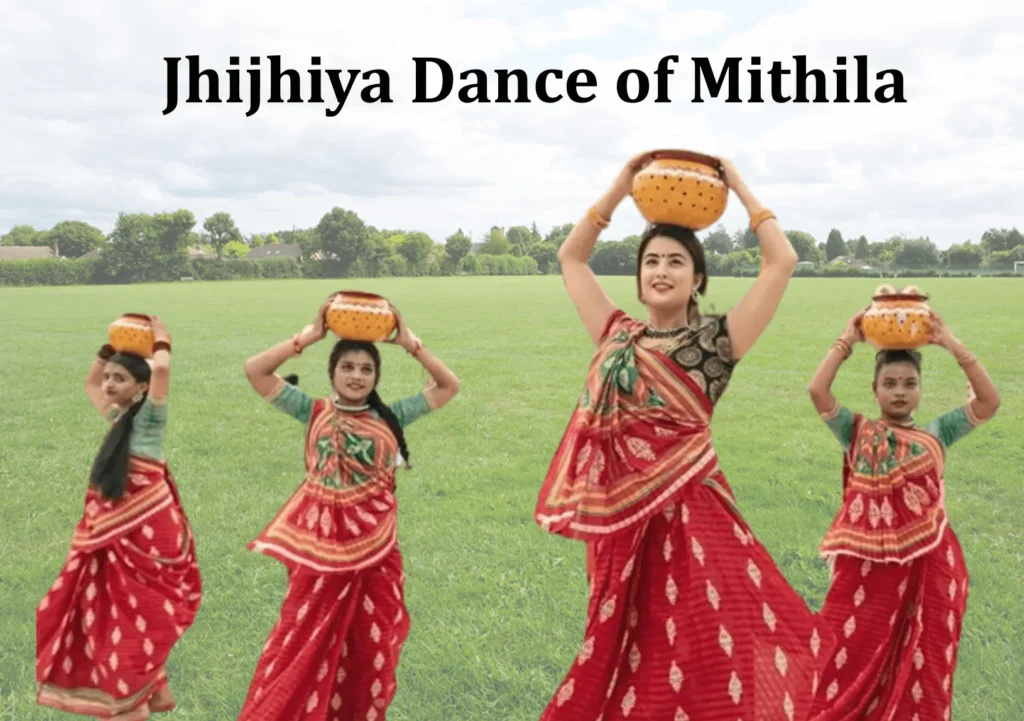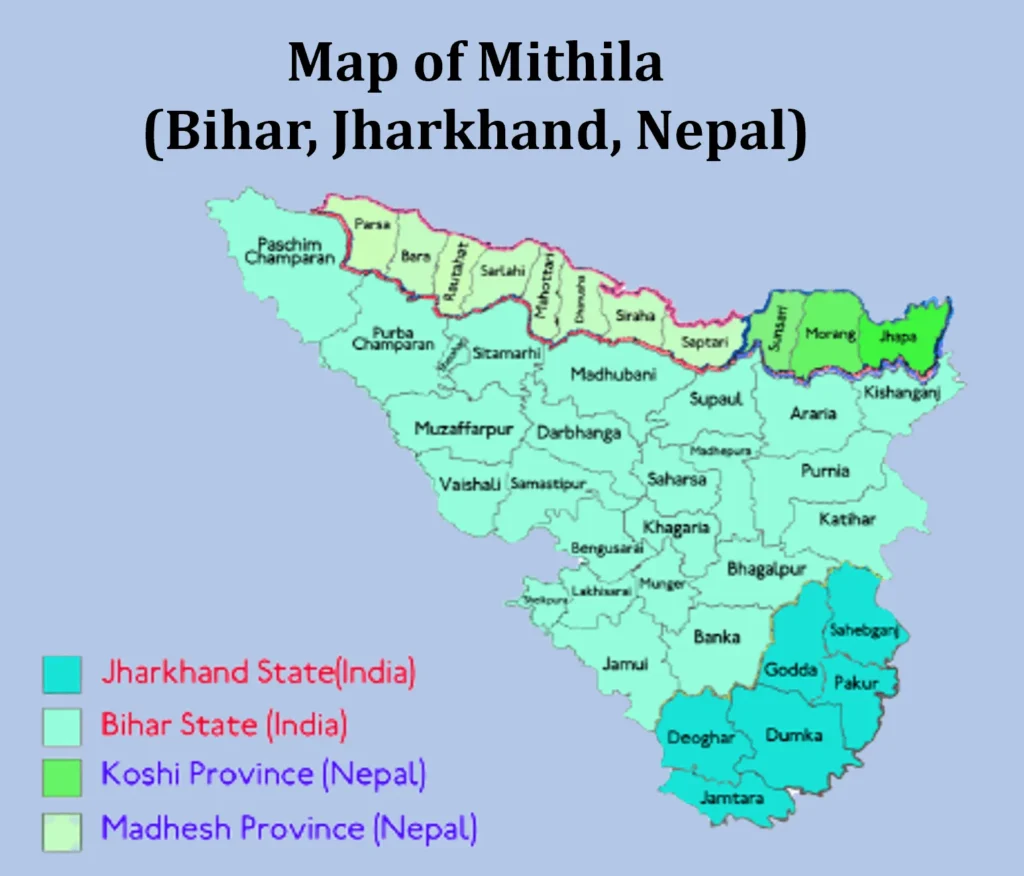
Deep within the heart of the Mithila region, where traditions echo through the ages and folklore weaves a captivating tapestry, lies the enchanting art of Jhijhiya Dance. Originating from the lands of India and Nepal, this cultural folk dance is a mesmerizing blend of tradition, devotion, and an intriguing tale of protection against witches and dark magic. In this unique blog post, we will take you on a journey to discover the captivating world of Jhijhiya Dance, exploring its origins, performance, and the enchanting legends that have kept this art alive.
Mithila: The Cradle of Jhijhiya Dance
It is essential to comprehend the history and cultural background of Mithila, the place from where the elegant dance form of Jhijhiya dances, before delving more into the art.
Known by several other names, including Tirhut or Tirabhukti, Mithila is a historic cultural province in northern India that mostly included what is now Bihar and Nepal. Known as the “Land of Sita,” since this is where the epic Ramayana’s beautiful consort Sita is said to have been born. For millennia, the Mithila region has been the birthplace of art, culture, and spirituality.

The region of Mithila has been linked to several artistic expressions, such as the well-known Madhubani painting, which is recognized for its elaborate patterns and striking hues. Jhijhiya Dance is yet another cultural gem from this region, and it reflects the essence of Mithila’s artistic heritage.
Origin and Historical Significance
Jhijhiya Dance is deeply rooted in the traditions of the Mithila region, which spans across parts of India and Nepal. The term “Jhijhiya” itself is derived from the Maithili language, spoken predominantly in this region. It is primarily performed during the Dusshera festival, in the Hindu month of Ashwin, which falls in September or October. This captivating dance, rich in cultural significance, is more than just a form of artistic expression; it’s a powerful medium for devotion and protection.
The dance’s origin, like many folk traditions, has an element of mystery. Passed down through generations in an oral form, there is no exact authority on the dance’s beginnings. However, Jhijhiya Dance has its own mythological tale that reflects the cultural and historical significance of this art form.
The Myth of Jhijhiya Dance
The myth associated with Jhijhiya Dance revolves around a king named Chitrasen and his queen, who was an adept practitioner of black magic. Concern arose due of the queen’s proficiency with black magic, especially because she was far younger than the king and they had no children. The king’s nephew, Balruchi, was chosen as his heir. The queen was enamored with Balruchi and made several unsuccessful attempts to court him.
Frustrated by her failed attempts, the queen resorted to dark magic. She pretended to be seriously ill and claimed that the only cure was to bathe in Balruchi’s blood. In a final attempt to save his beloved queen, the monarch ordered Balruchi to be put to death. But the troops could not murder him and send him back into the woods.
In the bush, Balruchi encountered an old woman who took him in and provided him with food and shelter. He had no idea that the elderly woman was a formidable witch. Meanwhile, the king’s men found Balruchi while they were passing through the jungle, posing a dilemma for the monarch and queen. An unexpected turn of events led to Balruchi being recognized by the king, thanks to a song that only the two of them knew.
When they arrived back at the palace, the queen asked Balruchi for forgiveness after realizing her mistake. Following a brief meeting with the elderly witch, Balruchi brought the king and queen back to the palace. He was declared as the king’s successor, and the queen introduced rituals to protect him through tantric practices. This ritual was then adopted by the common people, performed for the protection of their offspring and family.
Performance of Jhijhiya Dance
Jhijhiya Dance is performed by the people of the Mithila region, spanning both India and Nepal. The dance is a vital part of the Dusshera festival and is performed for ten consecutive evenings, from the day of Ghatasthapana to Bijaya Dashami. The significance of this dance goes beyond mere artistic expression; it is believed to protect children and society from the influence of witches and dark magic.
The dance involves women and girls, typically performing in groups of five to fifteen. They carry earthen pitchers on their heads, which hold a lamp and are adorned with multiple holes. The placement of the lamp inside the pitcher and the holes have a special significance. It is believed that if a witch can successfully count the holes on the pitcher, the dancer will meet an untimely demise.
Jhijhiya Dance commences on the first day of Dusshera, following a performance at a holy site. After this, it is tradition to go from house to house, showcasing the dance and asking for grains and food, which are used for offerings on the final day. On Vijayadashami, final prayers are offered, and the collected grains and money are used to organize a feast.
The Rhythms of Jhijhiya Songs
One of the distinctive features of Jhijhiya Dance is the accompanying music. The dance is accompanied by rhythmic songs, each with a specific purpose. There are two types of songs performed during the dance:
- Songs in Praise of the Goddess: These songs are dedicated to the goddess and are an integral part of the dance’s devotional aspect. They convey reverence and adoration.
- Songs for Protection Against Witches and Dark Magic: The second category of songs is designed to provide protection. They are believed to counteract the influence of witches and dark magic, safeguarding the performers and their communities.
These songs are typically sung in a repetitive and rhythmic manner as the dancers rotate in a fixed place, creating a mesmerizing spectacle.
Challenges and the Path Forward
While Jhijhiya Dance continues to be an essential part of Mithila’s cultural heritage, it faces certain challenges in today’s rapidly changing world. These challenges include:
- Modernization: The influence of modernization, urbanization, and the rapid pace of life can threaten traditional art forms like Jhijhiya Dance. Younger generations are often drawn to more contemporary forms of entertainment.
- Documentation and Preservation: Efforts to document and preserve Jhijhiya Dance are vital to safeguard its integrity. This includes recording the stories, movements, and rituals associated with the dance to ensure they are not lost to future generations.
- Socioeconomic Factors: Economic pressures and the need for stable livelihoods can sometimes discourage young individuals from pursuing traditional art forms as a career.
- Cultural Dilution: As Mithila’s youth are exposed to a multitude of cultural influences, it’s essential to ensure that Jhijhiya Dance remains relevant and continues to resonate with them.
Several initiatives have been launched in an effort to alleviate these issues. Cultural institutions, government support, and non-governmental organizations are working together to promote and preserve Jhijhiya Dance. These efforts focus on providing training and education to young Maithili artists, promoting the dance on a wider scale, and creating awareness about its cultural importance.
Conclusion
Jhijhiya Dance is not merely an artistic expression but a sacred tradition that continues to thrive in the Mithila region of India and Nepal. It carries with it a legacy of devotion, protection, and a captivating mythological narrative. Through the dance, people celebrate the triumph of good over evil, and it serves as a poignant reminder of the cultural richness that thrives in the heart of Bihar and Nepal.
As the rhythmic beats of Jhijhiya songs resonate and the earthen pitchers adorned with dancing flames spin gracefully on the heads of women, we witness the living heritage of Mithila come to life. Jhijhiya Dance is not just a dance; it’s a testament to the resilience of traditions, the power of devotion, and the enduring allure of the mystical lands of Mithila.
